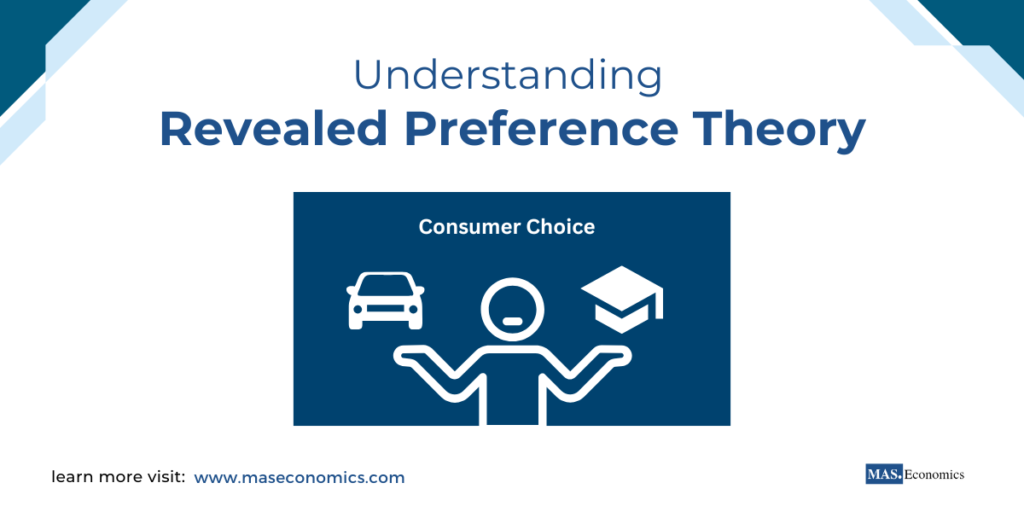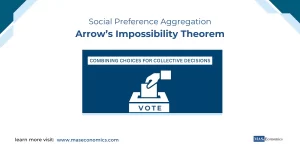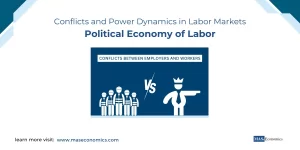In microeconomics, understanding how consumers make decisions and choose between different goods is central to analyzing market behavior. Two important concepts in this regard are the utility theory and the revealed preference theory. While utility theory seeks to quantify or rank the satisfaction a consumer gets from consuming goods, revealed preference theory bypasses subjective satisfaction and instead relies on actual consumer behavior to deduce preferences.
In this blog post, we will dive deeper into cardinal and ordinal utility theories and explore revealed preference theory, its importance, and its mathematical foundations in consumer choice theory.
What is Utility?
At the heart of consumer choice is the idea of utility, which refers to the satisfaction or pleasure that a consumer derives from consuming a good or service. Utility forms the basis for understanding how consumers make choices given their limited resources.
There are two main approaches to utility:
- Cardinal Utility Theory: Measures utility in specific units.
- Ordinal Utility Theory: Focuses on ranking preferences without assigning specific numbers to utility.
Cardinal Utility Theory
Cardinal Utility Theory posits that the satisfaction (utility) derived from consuming goods can be measured numerically. This theory assumes that utility can be measured in cardinal numbers, just as we measure height or weight. The notion of marginal utility—the additional satisfaction from consuming one more unit of a good—plays a central role here.
Mathematical Representation of Cardinal Utility:
Let’s assume that the utility derived from consuming good \(x\) is given by \(U(x)\), where \(U\) represents total utility. Cardinal utility theory also introduces the concept of marginal utility, \(MU\), which is the change in utility as consumption changes. Formally,
where \(MU_x\) is the marginal utility derived from consuming an additional unit of good \(x\). The law of diminishing marginal utility posits that \(MU_x\) decreases as \(x\) increases, i.e., each additional unit provides less and less additional satisfaction.
Example of Cardinal Utility:
Suppose a consumer derives the following utilities from consuming slices of pizza:
- 1st slice: 50 units of utility
- 2nd slice: 30 units of utility
- 3rd slice: 10 units of utility
Total utility is additive, meaning the consumer’s total utility from three slices of pizza is 90 units. However, diminishing marginal utility is evident as each additional slice provides less satisfaction.
Ordinal Utility Theory
Ordinal Utility Theory emerged to overcome the limitations of cardinal utility theory, particularly the difficulty of measuring utility directly. Instead of assigning numerical values, ordinal utility focuses on ranking preferences. Consumers can rank different bundles of goods, but they do not need to assign specific numbers to the satisfaction derived from each bundle.
Key Concepts of Ordinal Utility:
Ranking Preferences
Consumers can compare bundles and rank them, e.g., preferring bundle A over bundle B.
Indifference Curves
Graphical representations of different combinations of two goods that provide the same level of satisfaction. Along an indifference curve, the consumer is indifferent between the combinations.
Marginal Rate of Substitution (MRS)
The rate at which a consumer is willing to trade one good for another without changing their level of satisfaction.
Mathematical Representation of Ordinal Utility:
Let \(U(x, y)\) represent a utility function with two goods, \(x\) and \(y\). An indifference curve can be expressed as:
where \(k\) is a constant representing a specific level of satisfaction. The marginal rate of substitution between two goods is the slope of the indifference curve and is given by:
In simpler terms, MRS represents the amount of good \(y\) the consumer is willing to give up to obtain one more unit of good \(x\), while maintaining the same utility level.
Example of Ordinal Utility:
Suppose a consumer is choosing between apples and oranges. Indifference curves can show different bundles of apples and oranges that provide the same satisfaction. The consumer doesn’t need to measure how much utility they derive; they just rank the preferences between different bundles.
Revealed Preference Theory
Revealed Preference Theory, developed by economist Paul Samuelson, offers an alternative approach to understanding consumer behavior. Unlike utility theory, which is based on hypothetical or subjective measures of satisfaction, revealed preference theory draws conclusions about preferences from actual consumer choices.
Revealed preference theory avoids the need to measure utility directly. Instead, it posits that a consumer’s observed choices reveal their underlying preferences. If a consumer chooses one bundle of goods over another, it indicates that the chosen bundle is preferred, regardless of any specific utility function.
Assumptions of Revealed Preference Theory:
Rationality: Consumers are rational decision-makers. They choose the goods or bundles that maximize their utility given their budget constraints.
Consistency: Consumers’ preferences are stable and consistent over time. If a consumer prefers bundle A over bundle B at one point, they will not prefer bundle B over A at another time if all other factors remain unchanged.
Non-Satiation: Consumers always prefer more of a good to less. This assumption implies that consumers will never choose a bundle with fewer goods if a more extensive bundle is affordable.
Mathematical Foundations of Revealed Preference Theory
Revealed Preference Theory is grounded in several key axioms, particularly the Weak Axiom of Revealed Preference (WARP) and the Strong Axiom of Revealed Preference (SARP).
Weak Axiom of Revealed Preference (WARP):
If a consumer chooses bundle \(A\) over bundle \(B\) when both are affordable, it must hold that they will not choose \(B\) over \(A\) when both are available again. This establishes consistency in choice behavior.
Mathematically, if a consumer chooses bundle \(A\) when both \(A\) and \(B\) are affordable, then:
where \(p_A\) and \(p_B\) represent the prices of bundles \(A\) and \(B\), and \(x_A\) and \(x_B\) are the quantities of goods in the bundles. This implies that \(A\) is revealed as preferred to \(B\), and no future choice should reverse this preference.
Strong Axiom of Revealed Preference (SARP):
SARP extends WARP by applying the principle of transitivity across multiple choices. If a consumer reveals a preference for bundle \(A\) over \(B\), and \(B\) over \(C\), then they must also prefer \(A\) over \(C\). This axiom ensures consistency over more complex sets of choices.
Example of Revealed Preference Theory
Consider a scenario where a consumer is choosing between two bundles of goods:
- Bundle A contains 5 apples and 3 bananas.
- Bundle B contains 4 apples and 4 bananas.
If the consumer chooses Bundle A over Bundle B when both are affordable, the revealed preference theory allows us to infer that the consumer derives greater satisfaction from Bundle A. If, in a subsequent scenario, both bundles are available under the same conditions, the consumer should not choose Bundle B over Bundle A, assuming consistent preferences.
Revealed preference theory focuses entirely on these observable choices rather than subjective utility, making it highly applicable in empirical economic research.
Broader Implications and Applications of Revealed Preference Theory
Revealed Preference Theory is particularly useful in cases where direct measurement of utility is either impractical or impossible. It is widely applied in empirical studies to analyze consumer behavior, particularly using market data to infer preferences.
Key Applications:
Policy Analysis
Governments can observe consumer spending patterns to understand preferences and design policies that target welfare improvements.
Demand Estimation
Revealed preference data is used by firms and policymakers to estimate the demand for goods and services. By analyzing how consumers allocate their budgets, we can infer their willingness to pay for different goods.
Consumer Behavior Research
Revealed preference theory helps researchers study patterns of consumption and understand how economic agents respond to changes in prices, income, and other factors. This has critical applications in marketing, public policy, and behavioral economics.
Welfare Economics
By observing consumer choices, economists can evaluate the welfare effects of different market conditions, such as the introduction of a tax or subsidy, without relying on subjective utility functions.
Limitations of Revealed Preference Theory
Despite its empirical advantages, revealed preference theory has several limitations:
Assumption of Rationality
The theory assumes that consumers make rational choices, which may not always be true in real-world scenarios. Behavioral economics has shown that consumers often behave irrationally due to cognitive biases, framing effects, and other psychological factors.
Changing Preferences
The theory assumes that preferences remain constant over time, but in reality, consumer preferences can change due to various factors, including changes in taste, income, or external influences like advertising.
Limited Observability
Revealed preference theory relies on observed behavior, meaning it can only infer preferences from actual choices. In situations where consumers face budget constraints or limited choices, their true preferences may not be fully revealed.
Comparative Analysis: Utility Theory vs. Revealed Preference Theory
While both utility theory and revealed preference theory seek to explain consumer behavior, their approaches are fundamentally different.
| Aspect | Utility Theory | Revealed Preference Theory |
|---|---|---|
| Approach | Uses utility functions to explain consumer behavior | Infers preferences based on actual choices |
| Cardinal or Ordinal | Can be either cardinal or ordinal | Focuses on ordinal preferences deduced from behavior |
| Observability | Utility is theoretical and cannot be directly observed | Preferences are inferred from observable choices |
| Mathematical Foundation | Based on utility functions and MRS | Based on consumer choice axioms (WARP, SARP) |

|
||
Revealed Preference Theory has the advantage of relying on actual, observable behavior, making it practical for empirical applications, while utility theory provides a more theoretical foundation for understanding satisfaction.
Conclusion
Revealed Preference Theory offers a powerful, objective way to analyze consumer choices by observing actual behavior rather than relying on subjective utility measurements. It provides a practical framework for real-world applications and empirical research.
However, Utility Theory—particularly in its ordinal form—still plays a valuable role in economic analysis, especially when consumer behavior is examined in hypothetical or theoretical contexts. Together, these two approaches offer a comprehensive understanding of consumer choice, with revealed preference serving as a crucial tool for interpreting real-world decisions and utility theory providing a conceptual foundation for understanding satisfaction and preferences.
Both theories help economists understand and predict consumer behavior in different market environments, enhancing our ability to design better policies and improve welfare outcomes.
What is utility in economics?
Utility refers to the satisfaction or pleasure that a consumer derives from consuming goods or services. It is a key concept in consumer choice theory, helping to explain how individuals make decisions about what to purchase based on their preferences and the utility they receive.
What is the difference between cardinal and ordinal utility theory?
Cardinal Utility Theory
Assumes that utility can be measured in specific numerical units, allowing for exact quantification of the satisfaction derived from consuming goods.
Ordinal Utility Theory
Focuses on ranking preferences rather than assigning specific values. Consumers can rank different bundles of goods in terms of preference without quantifying the satisfaction levels.
Can you give an example of cardinal utility?
Suppose a consumer derives 50 units of utility from eating the first slice of pizza, 30 units from the second slice, and 10 units from the third slice. Cardinal utility theory assumes that utility can be measured and added up, so the total utility from consuming three slices of pizza would be 90 units.
What is ordinal utility theory, and how does it differ from cardinal utility?
Ordinal utility theory ranks preferences without assigning exact numbers to the satisfaction levels. For example, a consumer might prefer apples to oranges but doesn’t need to quantify how much more they like apples. This theory is often represented using indifference curves that show different combinations of goods that give the consumer the same satisfaction.
What are indifference curves in ordinal utility theory?
Indifference curves graphically represent combinations of two goods that provide the same level of satisfaction to a consumer. Each point along an indifference curve represents a bundle of goods between which the consumer is indifferent, meaning they derive equal satisfaction from any combination on that curve.
What is the Marginal Rate of Substitution (MRS)?
The Marginal Rate of Substitution (MRS) is the rate at which a consumer is willing to trade one good for another while maintaining the same level of utility. It is the slope of the indifference curve and represents the consumer’s willingness to substitute one good for another.
What is revealed preference theory?
Revealed Preference Theory, developed by Paul Samuelson, is an approach that analyzes consumer preferences based on their actual choices rather than hypothetical satisfaction levels. If a consumer chooses one bundle of goods over another when both are affordable, this reveals their underlying preference for that bundle.
How does revealed preference theory differ from utility theory?
Revealed preference theory focuses on observable behavior—how consumers make actual choices in the market—while utility theory involves hypothetical satisfaction or pleasure from consuming goods. Revealed preference theory does not require consumers to quantify their satisfaction; it only relies on the choices they make.
What is the Weak Axiom of Revealed Preference (WARP)?
WARP states that if a consumer chooses one bundle of goods (A) over another bundle (B) when both are affordable, they should not later choose bundle B over A under the same conditions. It establishes consistency in consumer choices, ensuring that their preferences remain stable over time.
What are some limitations of the revealed preference theory?
Assumption of Rationality
It assumes that consumers are always rational, which may not hold true in real-world scenarios where behavioral factors come into play.
Changing Preferences
The theory assumes stable preferences over time, which may not be realistic as consumer tastes and income levels change.
Limited Observability
Preferences are inferred only from observed choices, which may not capture a consumer’s true preferences in all situations, especially when they face budget constraints or limited options.
How is revealed preference theory applied in real-world economics?
Revealed preference theory is widely used in empirical studies to infer consumer preferences based on actual market behavior. It is useful in areas like demand estimation, welfare analysis, and policy evaluation, where consumer choices can reveal how they value different goods and services.
Why is ordinal utility theory often preferred over cardinal utility theory in modern economics?
Ordinal utility theory is preferred because it avoids the unrealistic assumption that utility can be precisely measured. Instead, it focuses on the relative ranking of preferences, which aligns better with how consumers actually make choices—by comparing and ranking different options, not by measuring satisfaction in numerical terms.
How do utility theory and revealed preference theory complement each other?
Utility theory provides a conceptual framework for understanding consumer preferences and satisfaction, while revealed preference theory offers a practical method for inferring those preferences based on observed choices. Together, they offer a comprehensive approach to analyzing consumer behavior both in theoretical and empirical contexts.
Thanks for reading! Share this with friends and spread the knowledge if you found it helpful.
Happy learning with MASEconomics



